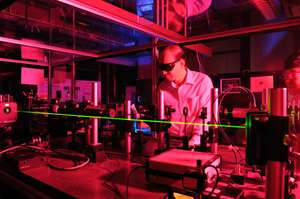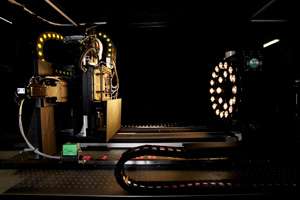Light-based technologies for measurement

Metrology ― the science of measurement ― plays an essential role in advancing science and technology. Precise definitions and measurements underpin almost all scientific and technological developments, from the astrophysical arena, such as sending a probe to Mars, through to the subatomic level, such as the discovery of the Higgs boson. What's more, metrology has practical applications that directly affect our everyday lives, such as determining the lifetime of lighting sources and color matching paints.
Light-based measurements
In addition to their work in electrical and mechanical metrology, A*STAR's National Metrology Centre (NMC) metrologists conduct research and provide industrial services in an emerging field of metrology based on light, known appropriately enough, as optical metrology. Xuebo Huang, principal metrologist and assistant head of the Optical Metrology Cluster at NMC, has been working in optical metrology for 20 years. "Optics is a fascinating field of physics that has become very important due to various new applications," he says.
Now, more than ever, visible light with its tiny wavelength, rapid oscillation and high manipulability is a vital component in a metrologist's toolbox. It can be used both as a ruler to measure distance and as a clock to measure time. In fact, some optical clocks are so stable and precise that it would take over 15 billion years for their time to be out by one second.
In addition to using light to measure physical quantities such as distance and time, optical metrologists also measure the physical parameters associated with light itself. Examples include accurately determining ultraviolet radiation levels, spectra of light sources and evaluating the power of a laser beam (see top image). Huang notes that these types of optical measurements are critical for the design and manufacture of reliable and safe products in vital growth industries such as medical technology, energy and aerospace.

Advancing metrology research
One of NMC's key responsibilities is to conduct research and development into the science of measurement to facilitate innovation in existing and emerging technologies. "One of our roles is to advance measurement science, and thus we conduct research to develop measurement technology and solutions to meet the emerging needs of industry," Huang explains.
Huang's research projects at NMC include establishing standards for laser power measurements, realizing a spectral responsivity scale, developing facilities for calibrating fiber optical measurement instruments and calibrating broadband ultraviolet radiometers, to name a few. He has also participated in several international comparisons and coordinated the Asia Pacific Metrology Programme comparison on irradiance responsivity of ultraviolet radiation detectors, the first such comparison in the world involving seven national metrology institutes.
Solar cell technology is advancing rapidly and many competing technologies are emerging on the horizon. To objectively evaluate the efficiency and performance of solar cell devices, NMC has developed primary standards and calibration capabilities with the high accuracy to provide direct measurement traceability for the solar industry, testing labs and research institutes in Singapore and South-East Asia. Such standards are essential for accurately characterizing, measuring and testing solar energy materials, devices and products (see lower image).
Another active research area is the development of measurement technology for characterizing solid-state lighting sources such as light-emitting diodes. Solid-state lighting is predicted to replace conventional light bulbs and fluorescent lighting in the near future, and is increasingly being used in many applications including medical diagnostic devices and display monitors. Standards and methods for measuring their performance, quality and safety are hence important. Researchers at NMC has developed spectral radiance measurement technology, standards and calibration facilities, which are critical for accurately measuring luminance (brightness) and color, as well as assessing the photobiological safety of light sources.
Huang finds this aspect of his work highly stimulating. "Optical metrology is finding more applications in many industries, making it both exciting and challenging to undertake research in this area," he enthuses.
Ensuring Singaporean industry measures up
NMC is responsible for establishing and maintaining the national measurement standards of Singapore. Its mission is to enhance measurement quality in the industry by providing a world-recognized measurement infrastructure. Hence, NMC's metrologists also deliver training courses, provide consultancy services and conduct calibration and measurement services, to constantly enhance the measurement quality.
Describing a typical day, Huang says he usually spends his mornings talking with customers or visiting companies to gain a better understanding of their requirements and to support their measurement needs. "In the afternoons, I will perform measurements for maintaining optical standards or international comparison to ensure that our optical measurement standards and capabilities are comparable and equivalent to other national metrology institutes." In addition, he provides regular training and consultancy on optical metrology with the aim of helping our industry partners to improve their skills in measurement science, calibration and uncertainty evaluation.
Looking to the future, Huang foresees that light-based technologies would be increasingly adopted in the medical industry. "With more applications of light sources in medical diagnosis and treatment, it is becoming more and more important to establish the safety of medical applications; this is an area in which optical metrology will play a critical role."
The research and development conducted at NMC will ensure that Singapore maintains a strong international presence in this vital field, while the services and training it provides to industry are critical for ensuring that Singaporean industry remains competitive. Light-based measurement has never been so important.



















